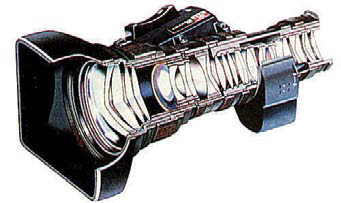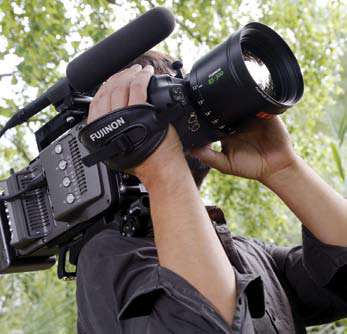Digital Electronics Push Optical Physics

This Canon ENG lens cross-section reveals the many elements of broadcast zoom lenses.
ALEXANDRIA, VA.—One of today’s truest tests of leading-edge optical glass technology is high resolution digital imaging. Broadcast zoom lenses are a complicated system of precision lens elements and related mechanics that HD made critical. NTSC resolution and CRTs were good at masking minor optical aberrations. HD, UHD and better remove masks and continually raise the optical quality bar for lens manufacturers. A viewing market of highly accurate large digital displays raises the end-to-end ante. A once- fixed target is now moving quickly.
THE BIG QUESTION
Let’s start with what many have asked. Why are HD broadcast lenses so expensive as compared to the lenses on smartphones? They both focus light to create stunning HD images on an imaging device.
The answer is that smartphone lenses are tiny and fixed focal length with minimal components. “Many of the current smartphones employ software to remedy distortion and other aberrations,” said Thom Calabro, director of marketing and product development at Fujifilm Optical Devices Division. In other words, the camera fixes what it can in real-time post.
Like squinting, small camera apertures common in most smartphones have a forgiving effect on focus. Larger apertures, such as 2/3-inch image sensors in HD and larger aperture UHD broadcast cameras, make optical quality significantly more critical.
“Almost all images, seen in isolation, can look very good; our human visual system always does an automatic optimization,” said Larry Thorpe, senior fellow at Canon U.S.A. “But when that iPhone [or other smartphone] image is seen next to identical image content taken by a high-end camera, then the differences can be startling.

Fujinon’s high-end Cabrio PL 85-300 lens uses a PL mount. “Sharpness, contrast, tonal reproduction, and color reproduction can all now be seen as quite subjectively superior to a picture taken by the smartphone,” Thorpe added. On the other hand, “good enough” has validity for many applications and circumstances these days.
Get the TV Tech Newsletter
The professional video industry's #1 source for news, trends and product and tech information. Sign up below.
Other than the usual physical specifications, what makes HD lenses different? “The HD lens is typically many elements of different sizes, shapes, and diverse glass materials,” Thorpe said. “All of those physical variables within that single-lens system is the essence of all that it takes to elevate the many optical performance parameters while simultaneously minimizing the multiple optical aberrations. This is a highly sophisticated science.”
Calabro says that Fujinon “specifies the materials that go into our glass. The make-up of the ingredients that are used will greatly affect the final product in such areas as colorimetry, transmittance, flare, and aberrations.” Special coatings optimize the performance of all of these very important factors.
Calabro went on to explain how mechanics affect lens quality. “Precision mechanics will assure that the elements stay where the designers intended,” he said. “They will help determine the accuracy in a zoom lens as it is moved throughout its range.”
COMPARE CONTRAST
Once the widest angle of view and zoom speed and range are identified, what should professional end users pay attention to when evaluating lenses? Contrast performance and resolution are fairly easy to observe and are typically called the “optical transfer function.” The value of relative contrast is known as the modulation transfer function. MTF values aren’t standardized, but it is often observed with variations of a Siemens star chart, ubiquitously known in TV station maintenance shops as the back-focus chart.
Similar to observing electronic resolution limits, MTF is usually observed with line pairs. An MTF of 1.0 is perfect. Where converging line pairs become a gray mass, the MTF is zero. Typically, people’s eyes distinguish a difference where the contrast between the lines falls to about half, known as MTF-50. What’s most important for HD imaging is how MTF values change across an entire image as compared to the center. If there’s an issue, it will generally appear as focus is incrementally changed.
Chromatic aberrations appear when a lens doesn’t focus all colors on the same plane. This can be a problem, as lenses have different refractive indices for different light wavelengths, and chromatic aberration may vary over the zoom range. The chemical composition of lens glass and coatings is specifically engineered to minimize chromatic aberrations.
Another difference can be vignetting, which may be observable at various zoom ranges and aperture settings. Focus tracking, geometric distortion, mechanical design, ruggedness, and electronic features are all familiar variables deserving due diligence.
Asked why people still use prime lenses, Fujinon’s Calibro replied “This is exactly our question!” He said a prime lens is cheaper, smaller and will “have a faster T-stop [transmittance], less aberrations [no moving elements] and be sharper.” But, he went on to say “our zooms go head-to-head with the best primes.” Zoom lenses are being increasingly adopted by cinematographers, but, a huge inventory of prime lenses at rental houses will ensure they won’t be abandoned anytime soon.
Thorpe said, “With more powerful software design tools and more powerful computers to do all of the hugely complex optimizations required (especially in zoom lenses), new glass materials are extending the ability to manage all of the huge number of variables in optical design, new optical coating materials and new deposition techniques.”
“One of the latest trends,” according to Calibro “is to have the camera correct for aberrations in the lens. The correction will not make a lens sharper, or allow it to pass light more efficiently, but, while not perfect, these circuits will improve lens aberrations.”
What are the biggest complaints and suggestions from users? Thorpe says Canon hears “some grumbling about the fact that lens costs do not lower over time at the same rate as those of digital cameras. Lenses remain intractably physical.”
Calibro says Fujinon hears similar stories. “As sensors go up in resolution—more pixels in a given space—it becomes harder to make a good lens. A lens that is outstanding on an SD camera will probably be OK on an HD camera, and unacceptable on a 4K camera. The problem is that lens aberrations that would not be seen in lower resolution cameras, are readily apparent in higher resolution ones. So while camera resolution has gone up and their prices have come down—mainly due to advances in electronics and production techniques—the lens pricing has gone up. Lenses have more to do with physics then electronics.”
